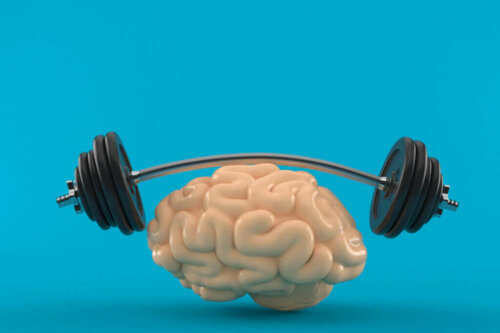Why It's Important to Increase the Basal Metabolic Rate

The basal metabolic rate refers to the necessary calories needed to perform basic bodily functions during the day. In this article, we’ll discuss the reasons why it’s important to increase the basal metabolic rate.
Many factors can affect the metabolic rate, for example, age, muscle mass, and diet. You may be trying to lose weight and want to increase the basal metabolic rate in an effort to burn more calories. However, achieving this goal is not quite that easy.
Consider that the faster your metabolism is, the more calories your body will need for basic functioning. In fact, this is the reason why most people can eat large quantities without gaining weight, while others tend to accumulate fat easily.
In any case, it’s necessary to know the factors that have a crucial impact on the basal metabolic rate. Keep reading to learn more.
Factors that affect metabolism
The metabolism is the speed at which the body burns calories and it plays a large role in weight loss. Unfortunately, there are many factors that can affect the metabolic rate. Here are just a few of the most important ones:
- Age: as we age, our basal metabolic rate slows down. Therefore, many people tend to gain weight as they age. In fact, studies suggest that aging is so important in metabolism because the amount of energy needed decreases.
- Body size: the bigger the body is, the more calories it will burn.
- Muscle mass: similar to the size of the body, the more muscle mass there is, the more energy the body will need.
- Physical activity: the more active a person is, the more calories the body will burn, and so, the metabolism will speed up.
- Environmental temperature: the body needs to burn more calories when it’s cold to avoid a drop in body temperature.

Why is it important to increase the basal metabolic rate?
Metabolism can vary depending on the person. Two people of the same size and similar body composition can have very different basal metabolic rates. Therefore, this is why many people can eat large quantities of food and not gain weight. While others have to count calories to maintain their weight.
Nonetheless, one way to lose weight without having to reduce calorie intake is to increase the basal metabolic rate. In fact, most of the energy we burn is during metabolic rest. Thus, this is an important factor that most people don’t consider.
On the other hand, physical activity represents only a small part of the energy we burn during the day. To this, we can also add the energy needed to digest food.
Among other positive aspects, healthy bodies have a higher basal metabolic rate than unhealthy ones. Consider that the basal metabolic rate increases with activity level. Therefore, experts recommend increasing daily activity.
How to increase the basal metabolic rate?
And now, you may want to know how to increase the basal metabolic rate. Well, it’s possible that your body isn’t burning calories fast due to poor nutrition and a sedentary lifestyle.
Fortunately, you can control this and reverse how the body behaves to increase the basal metabolic rate. And so, these are some things that can help you accomplish this:
- Rest more: lack of sleep can affect your appetite. Consequently, you end up eating more than you actually need.
- Wake up earlier, and never skip breakfast: skipping the first meal of the day could cause you to lose opportunities to reactivate your metabolism.

- Try to stay active by including exercise in your routine: cardiovascular exercises and strength training to gain muscle mass are ideal habits for people who want to increase their basal metabolic rate.
- Eat five to six times a day: eating small meals throughout the day can help your body to have enough available energy. Likewise, it will increase metabolism and brain capacity.
In conclusion, it’s true that some people have a faster metabolism in comparison to others. However, don’t forget that exercise is an efficient way to burn calories and increase the basal metabolic rate. Therefore, try to include activities such as walking, running, cycling, or swimming in your routine.
The basal metabolic rate refers to the necessary calories needed to perform basic bodily functions during the day. In this article, we’ll discuss the reasons why it’s important to increase the basal metabolic rate.
Many factors can affect the metabolic rate, for example, age, muscle mass, and diet. You may be trying to lose weight and want to increase the basal metabolic rate in an effort to burn more calories. However, achieving this goal is not quite that easy.
Consider that the faster your metabolism is, the more calories your body will need for basic functioning. In fact, this is the reason why most people can eat large quantities without gaining weight, while others tend to accumulate fat easily.
In any case, it’s necessary to know the factors that have a crucial impact on the basal metabolic rate. Keep reading to learn more.
Factors that affect metabolism
The metabolism is the speed at which the body burns calories and it plays a large role in weight loss. Unfortunately, there are many factors that can affect the metabolic rate. Here are just a few of the most important ones:
- Age: as we age, our basal metabolic rate slows down. Therefore, many people tend to gain weight as they age. In fact, studies suggest that aging is so important in metabolism because the amount of energy needed decreases.
- Body size: the bigger the body is, the more calories it will burn.
- Muscle mass: similar to the size of the body, the more muscle mass there is, the more energy the body will need.
- Physical activity: the more active a person is, the more calories the body will burn, and so, the metabolism will speed up.
- Environmental temperature: the body needs to burn more calories when it’s cold to avoid a drop in body temperature.

Why is it important to increase the basal metabolic rate?
Metabolism can vary depending on the person. Two people of the same size and similar body composition can have very different basal metabolic rates. Therefore, this is why many people can eat large quantities of food and not gain weight. While others have to count calories to maintain their weight.
Nonetheless, one way to lose weight without having to reduce calorie intake is to increase the basal metabolic rate. In fact, most of the energy we burn is during metabolic rest. Thus, this is an important factor that most people don’t consider.
On the other hand, physical activity represents only a small part of the energy we burn during the day. To this, we can also add the energy needed to digest food.
Among other positive aspects, healthy bodies have a higher basal metabolic rate than unhealthy ones. Consider that the basal metabolic rate increases with activity level. Therefore, experts recommend increasing daily activity.
How to increase the basal metabolic rate?
And now, you may want to know how to increase the basal metabolic rate. Well, it’s possible that your body isn’t burning calories fast due to poor nutrition and a sedentary lifestyle.
Fortunately, you can control this and reverse how the body behaves to increase the basal metabolic rate. And so, these are some things that can help you accomplish this:
- Rest more: lack of sleep can affect your appetite. Consequently, you end up eating more than you actually need.
- Wake up earlier, and never skip breakfast: skipping the first meal of the day could cause you to lose opportunities to reactivate your metabolism.

- Try to stay active by including exercise in your routine: cardiovascular exercises and strength training to gain muscle mass are ideal habits for people who want to increase their basal metabolic rate.
- Eat five to six times a day: eating small meals throughout the day can help your body to have enough available energy. Likewise, it will increase metabolism and brain capacity.
In conclusion, it’s true that some people have a faster metabolism in comparison to others. However, don’t forget that exercise is an efficient way to burn calories and increase the basal metabolic rate. Therefore, try to include activities such as walking, running, cycling, or swimming in your routine.
All cited sources were thoroughly reviewed by our team to ensure their quality, reliability, currency, and validity. The bibliography of this article was considered reliable and of academic or scientific accuracy.
- Albero, R., Sanz, A., & Playán, J. (2004). Metabolismo en el ayuno. Endocrinología y Nutrición, 51(4), 139–148. https://doi.org/10.1016/S1575-0922(04)74599-4
- Melier Vargas Z, Lilia Lancheros P, M. del P. B. (2011). Gasto energético en reposo y composición corporal en adultos. Rev Fac Med, 51 N.1(1), 16. https://doi.org/10.1016/S0716-8640(14)70644-3
- Gillooly, J. F., Brown, J. H., West, G. B., Savage, V. M., & Charnov, E. L. (2001). Effects of size and temperature on metabolic rate. Science, 293(5538), 2248–2251. https://doi.org/10.1126/science.1061967
- Lozano, A. (2010). Metabolismo. In L. E. Beltrán, F. Gutierrez, & G. Rozo Torres (Eds.), Biología: Conceptos y fundamentos básicos. (Segunda ed, pp. 145–164). Bogotá- Colombia: Fundación de Bogotá Jorge Tadeo Lozano. https://doi.org/10.1111/j.1365-2583.2010.01024.x.Decreased
This text is provided for informational purposes only and does not replace consultation with a professional. If in doubt, consult your specialist.








